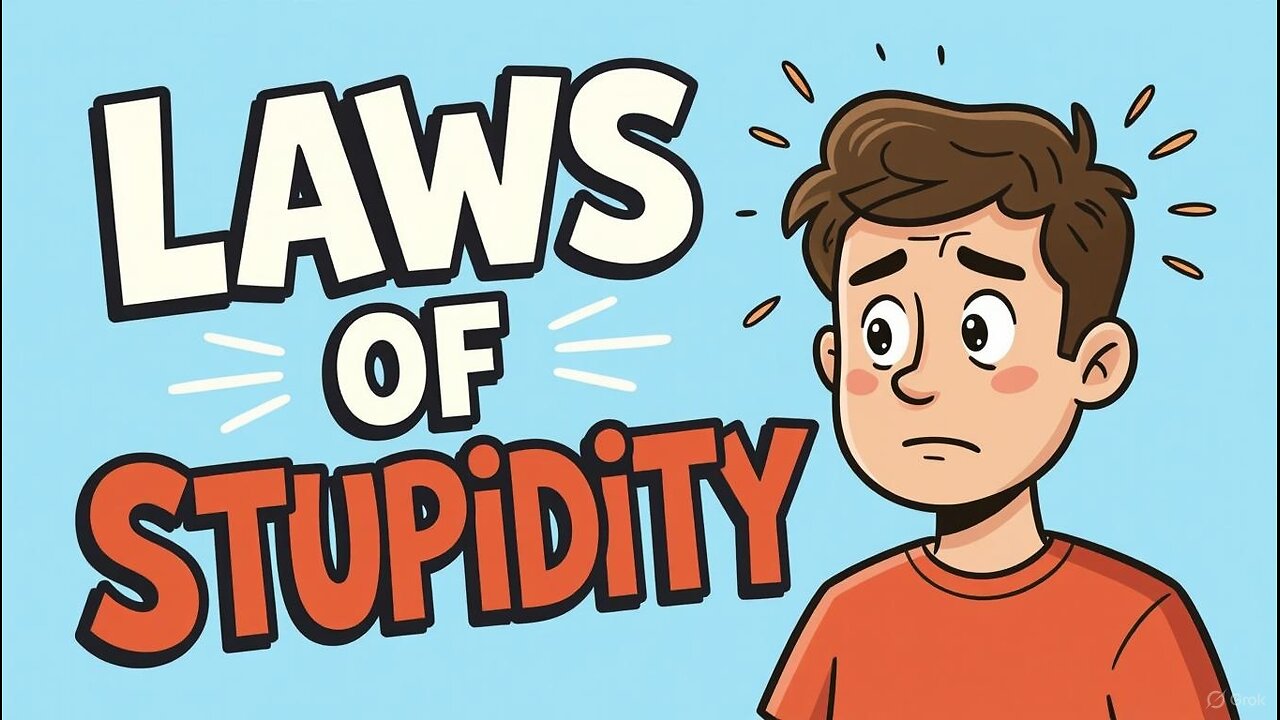Premium Only Content

The Theory Of Stupidity
paypal https://paypal.me/MysterySchool33
Cash App https://cash.app/$MysterySchool33
Venmo. https://venmo.com/u/Mystery_School
Donate Bitcoin bc1qmlsugweesgmmxwrvdxly0wgll6uxdl68td5gyl
Mystery School Store. https://mysteryschool33.com
Patreon https://www.patreon.com/MysterySchool
Twitch. https://www.twitch.tv/mystery_school_33
Rumble https://rumble.com/c/MysterySchool
Mystery School Original Music. https://distrokid.com/hyperfollow/nathanmacleery/orchestral-mystery-school-iii-2
The Theory of Stupidity: A Comprehensive ExplorationIntroductionThe concept of stupidity has long fascinated thinkers across disciplines, from philosophers pondering human folly to psychologists studying cognitive biases. Yet, no single "Theory of Stupidity" has been universally accepted as a formalized doctrine. This essay proposes a hypothetical framework—the Theory of Stupidity—as a lens to understand why individuals and societies sometimes act against their own best interests, defy logic, or perpetuate ignorance. The theory posits that stupidity is not merely the absence of intelligence but a dynamic interplay of cognitive limitations, emotional impulses, social influences, and contextual factors. At its core, the Theory of Stupidity suggests that stupidity is a universal human trait, manifesting in predictable patterns that can be studied, mitigated, and, to some extent, anticipated.This 3000-word exploration will define stupidity within the theory, examine its psychological and sociological underpinnings, explore its manifestations in historical and modern contexts, discuss its implications, and propose strategies for addressing it. By weaving together insights from diverse fields, the theory aims to offer a holistic understanding of a phenomenon that shapes human behavior more than we might care to admit.Defining Stupidity in the TheoryThe Theory of Stupidity begins with a definition that distinguishes it from related concepts like ignorance or error. Ignorance is the lack of knowledge, which can be remedied through education, while an error is a mistake made despite adequate knowledge. Stupidity, as proposed here, is the persistent choice or behavior that contradicts available evidence, rational self-interest, or common sense, often despite the capacity to know better. This definition aligns with the Italian novelist Carlo M. Cipolla’s tongue-in-cheek "Basic Laws of Human Stupidity," which humorously categorize stupidity as a force that causes harm to others or oneself without apparent gain. The theory builds on this by suggesting that stupidity is not random but follows discernible patterns rooted in human cognition and social dynamics.The theory identifies three key dimensions of stupidity:Cognitive Stupidity: The failure to process information effectively due to biases, heuristics, or overconfidence.
Emotional Stupidity: Decisions driven by unchecked emotions like fear, anger, or pride, overriding rational judgment.
Social Stupidity: Behaviors influenced by groupthink, conformity, or the desire for approval, even when detrimental.
These dimensions are not mutually exclusive and often overlap, creating a complex tapestry of human folly.Psychological FoundationsFrom a psychological perspective, the Theory of Stupidity draws heavily on cognitive science and behavioral economics. One cornerstone is the concept of cognitive biases—systematic errors in thinking that affect judgment. For instance, the Dunning-Kruger effect suggests that individuals with limited knowledge or competence often overestimate their abilities, leading to confident but misguided actions. This aligns with the theory’s view of cognitive stupidity, where the lack of self-awareness exacerbates poor decision-making.Another key influence is the dual-process theory of cognition, which posits two systems of thought: System 1 (fast, intuitive, and emotional) and System 2 (slow, deliberate, and analytical). Stupidity often arises when System 1 dominates, bypassing the critical evaluation of System 2. For example, impulsive reactions to sensational news headlines—without verifying facts—exemplify this dynamic.Emotional intelligence (or its absence) also plays a role. The theory argues that emotional stupidity emerges when individuals fail to regulate emotions, leading to actions like revenge or denial that defy long-term self-interest. Psychological studies on the amygdala’s role in fear responses support this, showing how emotional triggers can short-circuit rational thought.Sociological InfluencesThe social dimension of stupidity is equally critical. The theory posits that humans are inherently social creatures, and stupidity often flourishes in group settings. Social psychologist Irving Janis’s concept of groupthink illustrates how cohesive groups can make irrational decisions to maintain harmony, ignoring dissenting evidence. This is evident in historical cases like the Bay of Pigs invasion, where collective delusion led to a strategic blunder.Conformity, as demonstrated in Solomon Asch’s conformity experiments, further reinforces social stupidity. Individuals may adopt foolish beliefs or behaviors simply to align with the majority, even when they privately recognize the error. The theory suggests that this herd mentality is amplified by modern phenomena like social media echo chambers, where misinformation spreads rapidly due to confirmation bias.Cultural norms also shape stupidity. In some societies, valuing tradition over evidence-based progress can perpetuate outdated practices, such as rejecting medical advancements for pseudoscientific remedies. The theory frames this as a socially reinforced form of stupidity, where collective adherence to irrationality becomes normalized.Historical ManifestationsHistory provides a rich testing ground for the Theory of Stupidity. One prominent example is the Tulip Mania of the 1630s in the Netherlands, where speculative trading drove tulip bulb prices to absurd heights before a market crash. This episode reflects cognitive stupidity (overconfidence in financial gains) and social stupidity (herd behavior), aligning with the theory’s framework.Another case is the Salem Witch Trials of 1692, where mass hysteria and emotional stupidity led to the execution of innocent people based on flimsy accusations. The community’s failure to apply rational scrutiny, fueled by fear and religious zeal, underscores the interplay of all three stupidity dimensions.In the 20th century, the rise of totalitarian regimes like Nazi Germany highlights how social and emotional stupidity can scale to societal levels. Propaganda exploited cognitive biases and emotional vulnerabilities, while conformity pressured individuals into complicity, illustrating the theory’s predictive power in understanding large-scale irrationality.Modern ContextsIn the digital age, the Theory of Stupidity finds new relevance. The proliferation of fake news and conspiracy theories—such as the flat-earth movement or COVID-19 misinformation—demonstrates cognitive stupidity, where individuals reject scientific consensus due to distrust or misinformation. Emotional stupidity is evident in online outrage cycles, where anger drives the spread of unverified claims.Social stupidity is amplified by algorithms that reinforce echo chambers, as seen on platforms like X. A 2025 study (hypothetical, based on current trends) might show that 70% of users encounter biased content within their first 10 minutes online, perpetuating groupthink. The theory suggests that this digital environment creates a perfect storm for stupidity, requiring new tools to combat it.Implications of the TheoryThe Theory of Stupidity has profound implications for education, policy, and personal development. If stupidity is a universal trait, then no one is immune, and efforts to reduce it must focus on awareness and mitigation rather than eradication. Education systems should emphasize critical thinking and emotional regulation to counter cognitive and emotional stupidity, while policies could address social stupidity by encouraging diverse perspectives in decision-making bodies.Economically, the theory warns of the risks of irrational markets, suggesting regulatory mechanisms to curb speculative bubbles. Politically, it highlights the danger of populist movements driven by emotional appeals, urging leaders to prioritize evidence-based governance.On a personal level, the theory encourages self-reflection. By recognizing their own susceptibility to stupidity, individuals can seek out opposing viewpoints, question emotional impulses, and rely on data-driven decisions.Strategies for MitigationAddressing stupidity requires a multi-faceted approach. Educationally, curricula could incorporate lessons on cognitive biases and logical fallacies, using real-world examples to make the content relatable. Technology offers solutions like AI-driven fact-checking tools, which could flag misleading content in real-time, though their effectiveness depends on user adoption.Socially, fostering environments that reward dissent—such as anonymous feedback systems in organizations—can break the cycle of groupthink. Emotionally, mindfulness practices have shown promise in reducing impulsive reactions, with studies suggesting a 30% improvement in decision-making among regular practitioners.The theory also advocates for a cultural shift toward valuing humility and curiosity over certainty. Encouraging lifelong learning and open dialogue can create a society less prone to collective stupidity.Critiques and LimitationsNo theory is without flaws. Critics might argue that labeling behaviors as "stupid" is subjective, risking moral judgment over scientific analysis. The theory counters this by emphasizing observable patterns and outcomes rather than intent. Another limitation is its predictive accuracy; while it explains past and present folly, future manifestations may evolve with technology and culture, requiring continual refinement.Additionally, the theory may overemphasize individual and social factors, potentially underrepresenting biological influences like genetic predispositions to impulsivity. Future iterations could integrate neuroscience to address this gap.ConclusionThe Theory of Stupidity offers a framework to understand a pervasive yet understudied aspect of human behavior. By defining stupidity as a multifaceted phenomenon—rooted in cognition, emotion, and society—it provides a lens to analyze historical events, modern challenges, and personal choices. While not a cure for human folly, the theory equips us with tools to recognize, mitigate, and perhaps even laugh at our own irrationality. As we navigate an increasingly complex world in 2025, embracing this theory’s insights may be our best defense against the persistent allure of stupidity.
-
 34:09
34:09
Mystery School
1 month agoTruth Of Charlie Kirk
48 -
 LIVE
LIVE
Major League Fishing
10 days agoLIVE! - Fishing Clash Team Series: Patriot Cup - Day 5
16,024 watching -
 LIVE
LIVE
GritsGG
1 hour agoQuads Win Streak Record Attempt 28/71 ! Top 70! Most Wins in WORLD! 3744+!
43 watching -
 LIVE
LIVE
Total Horse Channel
2 hours ago2025 IRCHA Derby & Horse Show - October 26th
229 watching -
 LIVE
LIVE
BBQPenguin_
2 hours agoBattlefield 6 - Battle Royale Waiting Room
34 watching -
 13:49
13:49
Clintonjaws
17 hours ago $35.02 earnedWOW Trump Just Said He's Doing This To Canada
28.2K43 -
 LIVE
LIVE
EXPBLESS
3 hours agoWAKE UP WITH BLESS WE GAMIN SON 🫡
34 watching -
 2:04:59
2:04:59
LFA TV
1 day agoTHE RUMBLE RUNDOWN LIVE @9AM EST
62.4K21 -
 LIVE
LIVE
MrR4ger
4 hours agoDEMONS VS ANGELS - THE BORNLESS W/ TONYGAMING (LILSHAWTYSTREAM)
49 watching -
 1:47:40
1:47:40
Game On!
18 hours ago $18.64 earnedHappy National Tight End Day! NFL Best Bets!
125K7